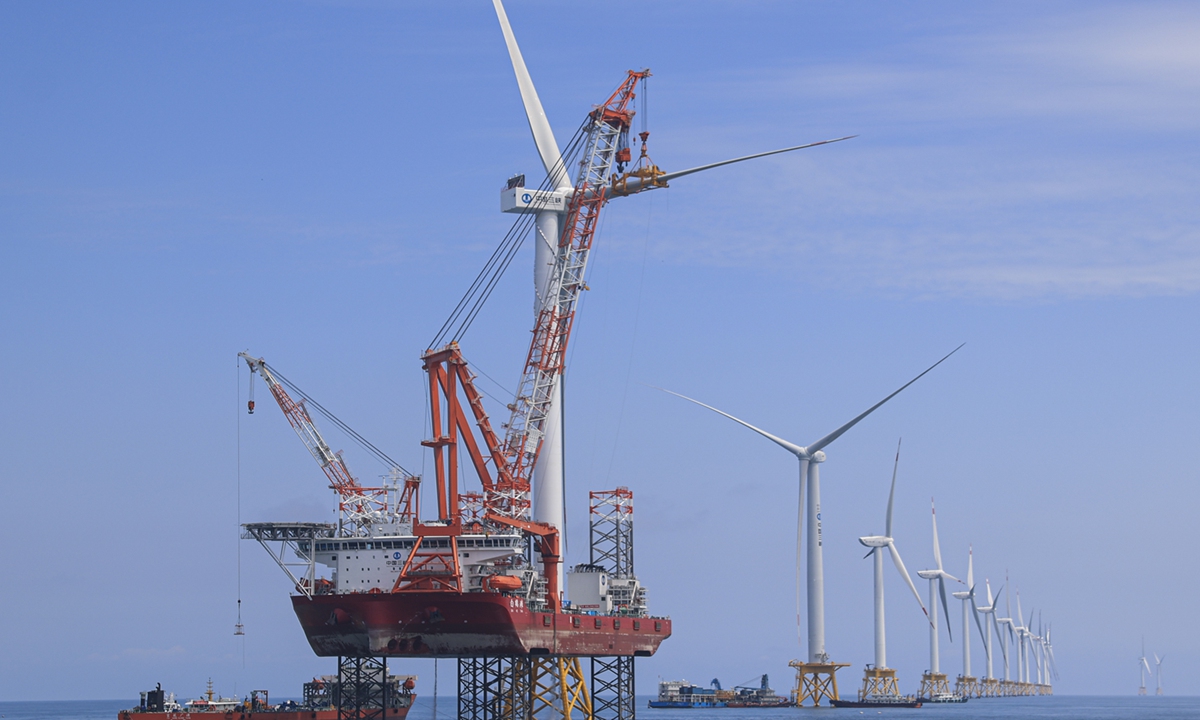
An offshore wind turbine stands in an offshore wind farm off the coast of Fujian Province. Photo: Yang Ruoyu/GT
China's deep-sea integrated large-scale wind power installation vessel
Bo Qiang 3060 conducted a trial voyage near the coastal city of Yantai in East China's Shandong Province on Wednesday.
Setting new domestic records including water depth, deck variable load and lifting capacity, the 133-meter-long vessel can operate in water up to 70 meters deep, according to media reports.
With a total variable load capacity of 11,000 tons, it can transport and install three sets of 16-megawatt offshore wind turbine units, making it the only next-generation wind power installation vessel in China capable of carrying entire tower sections, according to China Media Group.
The vessel was designed and built by Yantai CIMC Raffles Offshore (CIMC Raffles) and is the first vessel in the 3060 series. The vessel has a maximum lifting weight of 2,200 tons, and the crane can lift the hub of 20-mW wind turbine to a height of 160 meters, meeting the installation requirements for seas located off China, North Europe and Southeast Asia, according to Chen Changyong, a manager with CIMC Raffles'
Bo Qiang 3060 project.
As offshore wind farms expand into deeper seas, there are higher requirements for wind power installation in terms of water depth, large turbines and efficient operations, Chen said.
The
Bo Qiang 3060 has significantly improved the installation efficiency and adaptability to harsh marine weather conditions, ensuring an operational window of over 200 days per year, Chen said.
China has made major breakthroughs in building high-end, efficient and low-cost offshore wind power installation platforms suitable for various complex sea conditions.
According to data from UK-based Clarksons Research, offshore wind power is expected to continue its rapid development over the next 30 years, with its share of the global energy structure increasing from the current 0.3 percent to 7-9 percent by 2050.
New orders for global offshore wind power vessels in the first half of 2023 remained strong. Clarksons Research said there were 66 orders for offshore wind power vessels, up 6.5 percent year-on-year.
CIMC Raffles won three contracts worth of $851 million. With the implementation of China's "dual carbon" goal of reaching peak emissions by 2030 and attaining carbon neutrality by 2060, and the development of the marine clean-energy sector, there is still great potential for offshore wind power installation and maintenance work, CIMC said.
The trial operation of the vessel marks a major step in China's technological development, demonstrating that it has reached the international advanced level in the sector, according to Cong Yi, a professor from the Tianjin School of Administration.
There are more than 130 wind power installation vessels worldwide, and more than 100 were built in China.
Statistics from the China Association of the National Shipbuilding Industry showed that during the first three quarters of 2023, there was a "delivery peak" for offshore wind power-related vessels, with 20 vessels handed over to customers, setting a new record.
As of the end of October, among 37 orders for offshore wind power installation vessels globally, 33 were manufactured by Chinese shipyards.
The trial operation demonstrates the strength and determination of companies such as CIMC Raffles in independent innovation and technological research and development, injecting new impetus into the high-quality development of China's manufacturing industry. China should strive to increase its tech self-sufficiency and seize every opportunity to make breakthroughs in solving bottlenecks, striving to ensure core technologies are in its own hands, the expert said.




